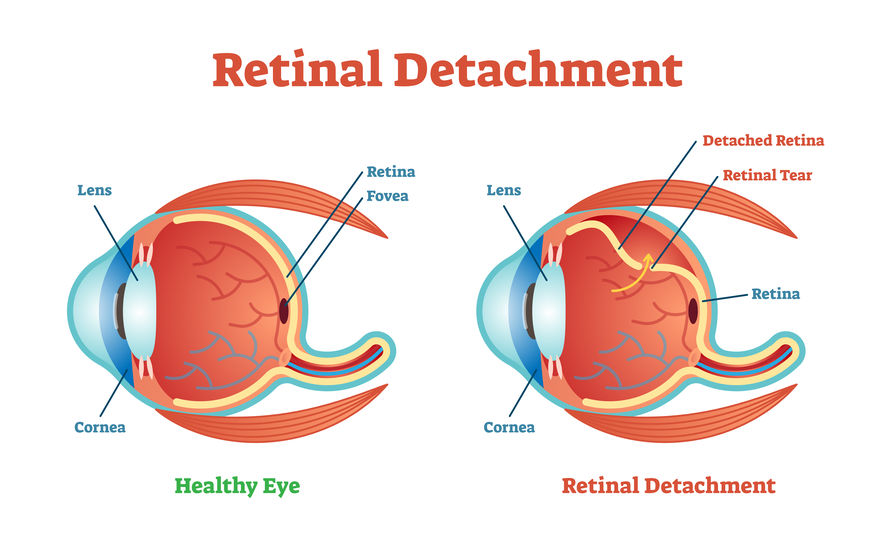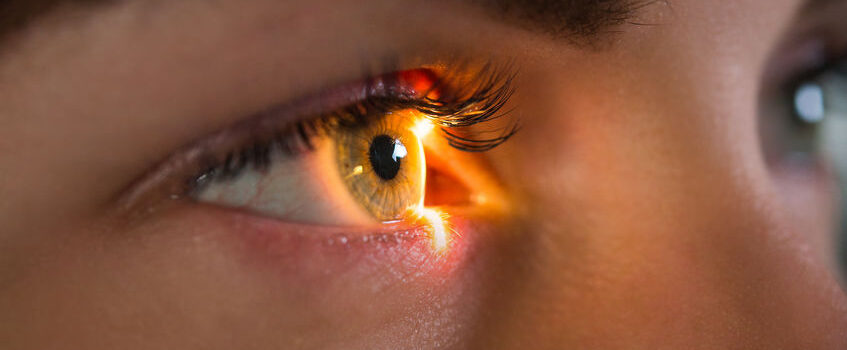What is retinal detachment?
Retinal detachment occurs when the vitreous jelly pulls away from the retina and the retina moves. This can be a medical emergency so early detection is crucial.
What does the retina do and where is it?
Very simply, the retina is a light-sensitive area at the back of the eye. It senses light and sends signals to the brain so you can see. The vitreous is the clear gel that fills the space between the lens and the retina. There is a place where that vitreous is tightly stuck to the retina and as we age, the vitreous can shrink and separate from the retina. This is called a posterior vitreous detachment (PVD) and normally does not damage the retina, even though people may see sudden floaters and light flashes.
However, sometimes the vitreous fibres can tear a hole in the retina as they pull away. If a retinal tear is diagnosed early, an eye specialist can seal the tear with laser treatment, avoiding visual loss.
Retinal damage is serious
If you don’t get treatment quickly, this retinal tear can lead to retinal detachment. This is when the vitreous detachment pulls the entire retina away from its normal position at the back of the eye, and this is not good.

Retinal detachments are urgent and typically require surgical repair by an experienced retina surgeon. A retinal detachment can require considerable recovery time and, in some cases, create long-term vision problems, or you can permanently lose your vision.
The good news though is that if help is sought early, the success rate for a recent, uncomplicated retinal detachment repair is around 90 per cent.
What are the symptoms?
Retinal detachment itself is painless and warning signs almost always appear before it occurs or has advanced. We all need to keep on the lookout for the sudden appearance of:
- many floaters or tiny specks that seem to drift through your field of vision.
- flashes of light in one or both eyes (photopsia)
- blurred vision
- gradually reduced side (peripheral) vision
- a curtain-like shadow over your visual field
- a sudden decrease in vision.
Seek immediate medical attention if you are experiencing any of these signs or symptoms of retinal detachment.
What are the risk factors?
The following factors increase your risk of retinal detachment:
- aging — retinal detachment is more common in people over age 50
- family history of retinal detachment
- extreme near-sightedness (myopia)
- previous cataract, glaucoma or other eye surgery
- a severe eye injury.
What are some preventative steps?
You can take the following steps to help prevent retinal tears and detachment:
- know the warning signs and seek immediate care if you experience any
- wear protective eyewear during sports and other dangerous activities.
- get an eye exam if you damage your eye in any way
- have regular eye exams.
The long and short of it
Retinal detachment can happen to anybody, but certain people have a greater chance of one happening: people with a high degree of nearsightedness, family history, eye trauma, or previous eye surgery. If you fall into any of these categories, you should have thorough retinal exams regularly.
Between our Henderson Optometry practice and our optometrists in Newmarket our staff has dedicated over 35 years’ helping Aucklanders through many a see change. If you’re at all worried about changes in your vision, call 09 522 1283 or 09 836 1731 to schedule a comprehensive eye test.

